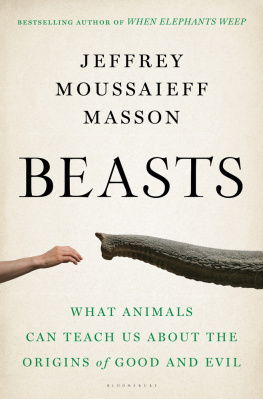ACKNOWLEDGMENTS
T HE FOLLOWING EXPERTS (IN SOME CASES, THE WORLDS AUTHORITY for their animal) were kind enough to read individual entries and make corrections and suggestions. They are not, obviously, responsible for any errors that despite my best efforts might still remain:
Gisela Kaplan, Arthur Evans, Rebecca Gotch, Valerius Geist, Can Slobodchikoff, Naomi Rose, Gerald Borgia, Patricia Earache, Mark Bekoff, Bryan Nelson, Eric Pianka, Aaron Bauer, David Merritt, Williamson and Hope Walker, Bill Barklow, Deborah Tabart, Eleanor Sterling and Ian Tattersall, Andrew Loveridge, Paul Sherman, Don Jellyman, Dietland Muller-Schwarze, James Wood, Naomi Rose, Anne Russon, Andrew Derocher, Robert Jackson, John Byers, Harley Shaw, David Baron, Ken Logan, Amanda Vincent, Manjula Tiwari, David Godfrey, Gale Bishop, Thomas Buckley, Gilia Angell, Androo Kelly, Nicola Nelson, George Archibald, David Mech.
I especially want to thank BTGBradley Trevor Greive, the Tasmanian Polar Bear, author of The Blue Day Book , who, out of pure kindness (and a love of animals), went far out of his way to find me experts to vet each entry.
For other help, I want to thank the following people: Oskar Conle, David Croft, Nina Fascione, Samantha Fenton, Jeff Flocken, Margaret Gee, Bradley Trevor Greive, Carl Safina, Rick Shine, Terese Storey, Jo Thompson, Lyall Watson, and Richard Wrangham. As usual my friend Nancy Miller has proved to be the treasure every author who has published with her knows her to be. I am so happy that Nancy Millers assistant, Lea Beresford, is back to help me, with competence and her unfailing cheerfulness so necessary to grumpy authors. I cannot adequately express my thanks to Dana Isaacson, who handles a literary scalpel with the skill of a surgeon and helped the thin book struggling to emerge from my obese manuscript into the light of day.
I want to thank my agent, the incomparable Andy Ross (who owned what many consider to have been the best book store in AmericaCodys) for putting together a deal that allowed this book, the favorite of my 24 books, to be re-incarnated in a new and better body. The people who actually made it happen are all the wonderful people at Skyhorse Publishing: First, my editor, Ann Treistman, whose idea it was; Julie Maytsik found the art and helped tremendously with the manuscript; Tony Lyons, the publisher, gave the green light for this somewhat unusual book and I am grateful for his courage, and finally I want to thank Abigail Gehring for her input into making this the nicest such book I have ever seen! I am deeply grateful to all of you!
Also by Jeffrey Moussaieff Masson:
Raising the Peaceable Kingdom: What Animals Can Teach Us About the Social Origins of Tolerance and Friendship
The Cat Who Came in from the Cold: A Fable
Slipping into Paradise: Why I Live in New Zealand
The Pig Who Sang to the Moon: The Emotional World of Farm Animals
The Nine Emotional Lives of Cats: A Journey into the Feline Heart
The Evolution of Fatherhood: A Celebration of Animals and Human Families
Dogs Never Lie About Love: Reflections on the Emotional World of Dogs
The Wild Child: The Unsolved Mystery of Kaspar Hauser
When Elephants Weep: The Emotional Lives of Animals (with Susan McCarthy)
My Fathers Guru: A Journey Through Spirituality and Disillusion
Final Analysis: The Making and Unmaking of a Psychoanalyst
Against Therapy: Emotional Tyranny and the Myth of Psychological Healing
A Dark Science: Women, Sexuality, and Psychiatry in the Nineteenth Century
The Assault on Truth: Freuds Suppression of the Seduction Theory
The Oceanic Feeling: The Origins of Religious Sentiment in Ancient India
The Complete Letters of Sigmund Freud to Wilhelm Fliess 18871904 (Editor)
The Peacocks Egg: Love Poems from Ancient India (Editor, Translations by W. S. Merwin)
The Dhvanyaloka of Anandavardhana with the Locana of Abhinavagupta
(Translator, with D. H. H. Ingalls and M.V. Patwardhan)
Avimaraka: Loves Enchanted World (with D. D. Kosambi)
Aesthestic Rapture: The Rasadhyaya of the Natyasastra
(Translator and Editor with M. V. Patwardhan; two volumes)
Santarasa and Abhinavaguputas Philosophy of Aesthetics (with M. V. Patwardhan)
Dogs Have the Strangest Friends, & Other True Stories of Feelings (for children)
ARMADILLOS
A RMADILLO IS A SPANISH WORD REFERRING TO THE ARMORLIKE shell protecting this remarkable animal. This defense system led early zoologists to classify them with turtlesand allowed this animal to survive for 55 million years. I recently saw a photo of an armadillo on the Web that totally captured me: It was rising vertically in the air. The caption explained that when armadillos are surprised, they often jump straight up! Travelers in Americas Gulf States often see them by day scattered along the roadside after theyve been killed during the night by cars and trucks. But being hit by the wheel isnt what kills them. Rather, it is their unusual jump reflex: When a car roars over them, they bound off the road almost vertically, hitting a cars underside. I am not sure how this startle response evolved. Did it unnerve their predators? And then of course there are species of armadillos constructed so that they can curl up in a ball, completely safe from any predation.
Armadillos are distant cousins of anteaters and sloths, who originally come from South America. There are at least twenty species, ranging from the fairy armadillo, only 5 inches long and weighing in at 3 ounces, to the giant armadillo, who is almost 4 feet long and weighs 130 pounds. The best known is the nine-banded armadillo Dasypus novemcinctus (so called because of the nine movable bands on the like skin). Perhaps the term best known glosses over the fact that almost nothing is known about the other living armadillos, even less about the extinct ones. The nine-banded armadillo existed in the United States several million years ago and then vanished five to ten thousand years ago for unknown reasons, only to reemerge in Texas in 1854. (Today they are found from Argentina to Colorado.)
We tend to associate the nine-banded armadillo with the Lone Star State, primarily because Texans have taken to armadillos. Just this one species of armadillo lives in Texas. And a good reason they are welcome is that, like their cousins, they are inordinately fond of ants, especially fire ants, the scourge of the state. For some reason, armadillo races are popular with humans in Texas, though there is no evidence that armadillos share the enthusiasm.

Scientists are fond of armadillos for a number of reasons. One is that a reproducing female armadillo can delay implantation for several months, and gestation can last up to twenty monthsas long as an elephant. The New Encyclopedia of Mammals (2001), reports a case where a female gave birth three years after the last date at which she could possibly have been inseminated! Thats not all: After this long gestation, she gives birth to identical quadruplets, all coming from a single egg. The embryo divides in two, and those two embryos divide into two more. Armadillos are the only mammals who routinely give birth to genetically identical quadruplets. Derived from a single fertilized ovum, all the babies are of the same sex and all contain identical sets of genes, a treasure trove for geneticists.












